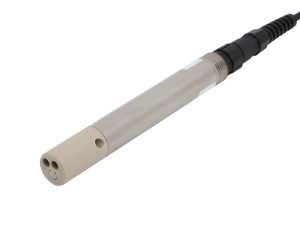Water Conductivity Meter: The Essential Tool for Environmental Research

Water quality monitoring plays a critical role in protecting our environment and ensuring the health of aquatic ecosystems. As urbanization and industrialization continue to expand, the monitoring of water bodies such as rivers, lakes, and groundwater becomes increasingly important. One of the essential parameters in water quality testing is conductivity, which measures the ability of water to conduct electrical current. This is influenced by the concentration of dissolved ions, such as salts, minerals, and pollutants in the water.
A Water conductivity meter is a powerful tool used in environmental monitoring to assess the quality of water in real-time. In this blog, we will discuss the significance of water conductivity meters in environmental monitoring, how they work, and the role they play in ensuring water safety and ecosystem health.
What is Water Conductivity?
Conductivity is a measure of how well water can conduct an electrical current. It is influenced by the presence of dissolved ionic substances such as salts, minerals, and pollutants. The more ions that are present in the water, the higher the conductivity. Pure water, like distilled water, has very low conductivity because it contains few dissolved ions. However, the presence of dissolved substances such as salts, minerals, metals, and other pollutants increases the water’s conductivity.
In environmental monitoring, conductivity is a key indicator of water quality. Elevated conductivity levels can indicate pollution, the presence of industrial waste, or saline intrusion. On the other hand, low conductivity may be associated with very pure or demineralized water.
How Water Conductivity Meters Work
A water conductivity meter typically works by passing an electrical current between two electrodes submerged in the water. The meter then measures the current that flows through the water, which is directly related to the number of dissolved ions present in the water. The conductivity meter converts this electrical signal into a conductivity reading, typically expressed in microsiemens per centimeter (µS/cm).
Most modern conductivity meters also feature automatic temperature compensation (ATC). This is important because temperature affects conductivity measurements — warmer water typically has higher conductivity. ATC adjusts the readings to account for variations in temperature, ensuring that the data remains accurate under different environmental conditions.
The Importance of Conductivity in Environmental Monitoring
Monitoring water conductivity is essential for understanding the health of aquatic ecosystems and detecting the presence of harmful substances in water. Below are the key reasons why conductivity is crucial in environmental monitoring:
1. Detecting Pollution and Contamination
One of the primary reasons for monitoring water conductivity is to detect contamination. High conductivity levels can signal the presence of dissolved substances, many of which may be harmful to aquatic life. These substances can include:
-
Industrial pollutants: Chemicals and heavy metals from factories and industrial runoff.
-
Agricultural runoff: Excessive use of fertilizers and pesticides can introduce nutrients and chemicals into water bodies, raising conductivity.
-
Saline intrusion: In coastal areas, saltwater intrusion due to rising sea levels or over-extraction of freshwater can increase conductivity in freshwater systems.
By regularly measuring conductivity, environmental agencies can detect pollution before it becomes a significant problem and take necessary actions to mitigate its impact.
2. Monitoring the Health of Aquatic Ecosystems
Conductivity is an important parameter when assessing the health of aquatic ecosystems. Different species of plants and animals thrive in specific conductivity ranges. Significant changes in conductivity can stress aquatic life, disrupt ecosystems, and lead to biodiversity loss.
For example, freshwater species such as fish, amphibians, and invertebrates are typically adapted to low-conductivity environments. An increase in conductivity may indicate a change in water chemistry, which could be harmful to these species. Conductivity levels that are too high or too low may lead to hypoxia (low oxygen levels) or other environmental stresses, reducing the survivability of aquatic organisms.
In ecosystems such as wetlands, where the water quality is directly linked to biodiversity, conductivity measurements can provide valuable insights into ecosystem health. If conductivity levels rise due to increased salinity, certain freshwater species may no longer be able to survive, leading to a decline in biodiversity.
3. Tracking Long-Term Environmental Changes
Over time, water conductivity can reflect changes in the environment. For example, as urban areas expand, increased pollution runoff can raise conductivity levels in nearby rivers and lakes. In contrast, increased conservation efforts, such as better agricultural practices or reduced industrial waste, may lead to a decrease in conductivity.
By establishing a baseline for conductivity levels in a water body, scientists and environmental agencies can track changes over time and assess the effectiveness of environmental protection measures. For instance, a river that has been subject to industrial waste runoff may show consistently high conductivity levels. Monitoring changes in conductivity can indicate the success of efforts to reduce pollution.
4. Assessing Water Quality for Drinking Water
Water conductivity meter also play a key role in ensuring the safety of drinking water. High conductivity in drinking water could indicate the presence of dissolved solids, which could affect its taste and pose health risks. For instance, excess minerals such as calcium and magnesium can make water “hard,” which may cause scaling in plumbing systems and affect household appliances.
By measuring conductivity in water treatment facilities, operators can monitor water quality in real time and adjust treatment processes as needed. Additionally, conductivity monitoring helps meet regulatory requirements and ensures that water supplied to the public is safe and clean.
5. Supporting Water Treatment and Remediation Efforts
When water bodies are polluted, remediation efforts are required to restore the water’s quality. Conductivity meters provide real-time feedback on the effectiveness of water treatment and remediation processes. For instance, after adding chemicals to remove pollutants or reduce salinity, conductivity readings can be used to assess how well these interventions are working.
In some cases, conductivity measurements can also be used to monitor the effectiveness of water filtration systems, ensuring that they are operating at full capacity and producing high-quality water. Additionally, they can help optimize the use of chemicals in water treatment processes, reducing costs and minimizing environmental impact.
Applications of Water Conductivity Meters in Environmental Monitoring
1. Rivers and Lakes
Water conductivity meters are widely used to monitor the health of rivers, lakes, and other freshwater bodies. These devices can provide real-time data on conductivity, allowing environmental agencies to detect changes in water quality and respond accordingly. For example, if a river’s conductivity increases suddenly, it may indicate the presence of pollutants, and authorities can investigate the source of contamination.
2. Groundwater Monitoring
Conductivity meters are essential for monitoring groundwater quality, particularly in areas where underground water is used for drinking or irrigation. Elevated conductivity levels in groundwater can indicate contamination from agricultural runoff or industrial waste. By regularly monitoring conductivity, environmental agencies can detect potential contamination sources before they affect the water supply.
3. Coastal and Marine Ecosystems
In coastal regions, where freshwater and saltwater mix, monitoring conductivity is critical for understanding the health of both the freshwater and marine ecosystems. Conductivity meters can be used to detect saline intrusion into freshwater aquifers or changes in the salinity of coastal waters, which can have significant impacts on local marine life.
4. Wetlands and Estuaries
Wetlands and estuaries are highly sensitive ecosystems that depend on a balance of freshwater and saline water. Conductivity meters are used to monitor the salinity levels in these ecosystems, ensuring that conditions remain suitable for the species that inhabit them. As climate change accelerates, saline intrusion due to rising sea levels is becoming a growing concern, and conductivity measurements can help track these changes.
5. Industrial Effluent Monitoring
Industries that discharge effluent into natural water bodies are often required to monitor and control the quality of their wastewater. Conductivity meters are commonly used to assess the quality of effluent being released into rivers, lakes, or oceans. By monitoring conductivity, industries can ensure that they are complying with environmental regulations and avoiding contamination of nearby ecosystems.
Conclusion
Water conductivity meters are indispensable tools in environmental monitoring, providing valuable insights into the quality of water bodies and the health of ecosystems. By measuring the conductivity of water, these meters help detect pollution, monitor long-term changes, and ensure that water is safe for consumption and aquatic life.
In the face of growing environmental concerns such as pollution, climate change, and the depletion of freshwater resources, water conductivity meters will continue to play a critical role in safeguarding our water resources. Through regular monitoring and timely action, we can ensure that water remains a safe, sustainable resource for future generations.









